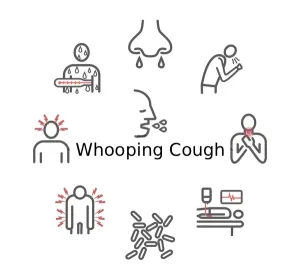Overview
Diagnosis
Whooping cough, also known as pertussis, is diagnosed based on symptoms, clinical examination, and laboratory testing. Because early symptoms often resemble those of a common cold, proper testing is essential for confirmation.
Healthcare professionals may use the following methods to diagnose whooping cough:
-
Medical history and symptom review: Persistent coughing fits followed by a “whooping” sound when inhaling, vomiting after coughing, and long-lasting cough are key indicators.
-
Physical examination: The doctor may listen to the lungs and assess the severity of the cough and breathing pattern.
-
Nasal or throat swab test: A sample is collected from the back of the nose or throat and tested for Bordetella pertussis bacteria using a polymerase chain reaction (PCR) test or culture.
-
Blood tests: In some cases, blood tests are done to check for elevated white blood cell counts or antibodies to B. pertussis.
-
Chest X-ray: If pneumonia or other complications are suspected, a chest X-ray may be performed.
Early diagnosis helps prevent the spread of infection, especially to infants and vulnerable individuals.
Treatment
The goal of treatment is to control the infection, relieve symptoms, and prevent transmission to others. Treatment is most effective when started early in the course of the illness.
Common treatment strategies include:
-
Antibiotics:
-
Macrolide antibiotics such as azithromycin, clarithromycin, or erythromycin are typically prescribed to kill the bacteria and reduce contagiousness.
-
If given early, antibiotics can shorten the duration and severity of symptoms.
-
Family members and close contacts may also receive preventive antibiotics to stop further spread.
-
-
Supportive care:
-
Rest and adequate hydration are important for recovery.
-
Cough medicines are generally not recommended, as they are usually ineffective for whooping cough.
-
A cool-mist humidifier may help soothe irritated airways.
-
-
Hospital care: In severe cases, especially in infants, hospitalization may be needed for oxygen therapy, suctioning of mucus, and close monitoring.
Prevention
Vaccination is the best way to prevent whooping cough. The DTaP vaccine (for children) and Tdap booster (for adolescents and adults) protect against Bordetella pertussis. Pregnant women are also advised to receive a Tdap booster during each pregnancy to pass protective antibodies to their baby.
Early detection and timely antibiotic treatment not only help recovery but also play a vital role in controlling outbreaks and protecting vulnerable populations.
Advertisement

